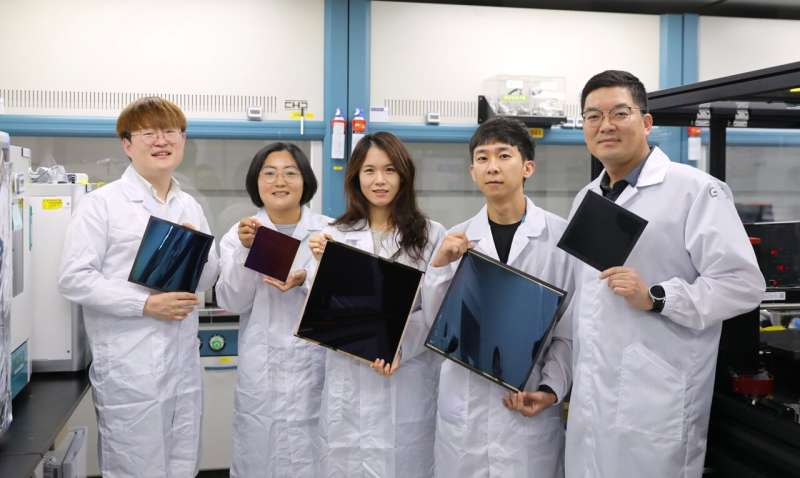
November 14, 2024 by National Research Council of Science and Technology
Collected at: https://techxplore.com/news/2024-11-efficiency-large-area-perovskite-solar.html
In response to the urgent need to meet the national greenhouse emission reduction goals set by the “Framework Act on Carbon Neutrality and Green Growth for Coping with Climate Crisis,” specifically including the “2030 Nationally Determined Contribution (NDC) Target of 40% Greenhouse Gas Reduction,” and “Net Zero Carbon Emissions by 2050,” a Korean research team in collaboration with a domestic company has developed new technology that resulted in surpassing the world record for efficiency of large-area perovskite solar cells.
The Korea Research Institute of Chemical Technology (KRICT) and UniTest Co., Ltd., headed by Jong-Hyun Kim, have jointly developed a technology to produce highly efficient, large-area perovskite solar cells (over 200 cm2). This new technology achieved a certified efficiency of 20.6%, breaking the previous world record of 19.2% held by UtmoLight.
On May 7, 2024, the efficiency was officially certified by the internationally recognized Fraunhofer Institute in Germany, and the record was listed on the “Champion Module Efficiency Chart” of the U.S. National Renewable Energy Laboratory (NREL) on June 21.
KRICT and UniTest Co., Ltd. plan to accelerate the commercialization of perovskite solar cells by utilizing this breakthrough technology. They are preparing for mass production of perovskite solar cells for various applications such as indoor photovoltaic products, building-integrated photovoltaics (BIPV), and other functional devices, with some products expected to reach the market within this year.
Background and significance of the technology
Perovskite solar cells have gained attention as next-generation solar cells because they can be mass-produced at a relatively low cost by a low-temperature solution process with various substrates.
Currently, many countries worldwide, including the Republic of Korea, China, Europe, and nations in the Middle East such as Saudi Arabia are engaged in a highly competitive race to enhance the efficiency and commercial viability of perovskite solar cells.
The theoretical efficiency limit for large-area perovskite solar cells is estimated to be around 27% when considering realistic loss mechanisms. However, no technology previously had achieved over 20% efficiency in practical applications.
Improving efficiency entails various tasks such as optimization of device structure, tailoring properties of materials, uniform coating, and laser processes, which are challenging to achieve consistently across large-scale devices.
High-performance, large-area perovskite solar cells are also crucial for developing perovskite-silicon tandem solar cells, which are essential for overcoming the efficiency limits of traditional silicon solar cells. Improving the efficiency of single-junction large-area perovskite solar cells is thus a key step toward advancing the performance of tandem devices and modules.

Achievements and future directions
KRICT’s perovskite research team has optimized its in-house material synthesis methods, film uniformity by scalable processes, and laser ablation control, resulting in a certified efficiency of 20.6% for large-area perovskite solar modules (>200cm2), significantly surpassing the previous record of 19.2%.
The newly developed large-area, single-junction perovskite solar cell technology is directly applicable to large-area production processes for perovskite-silicon tandem solar cells, and thus is a critical innovation for early commercialization in this sector.
Based on this technology, KRICT is conducting outdoor operation stability tests (ISOS-O-1) and playing a pivotal role in supporting the commercialization of these cells by industry partners.
UniTest Co., Ltd. is utilizing this technology to accelerate its ongoing commercialization of perovskite-based products, including glass-integrated perovskite solar cells and the development of semi-transparent perovskite cells for panoramic solar roofs in collaboration with major domestic automotive manufacturers.
The company is also establishing facilities to mass-produce indoor perovskite solar cells, aiming to commence production by the end of this year.
Young-Kook Lee of KRICT stated, “This achievement represents a significant milestone in overcoming one of the key technical barriers for the commercialization of large-area perovskite cells, marking a major success in industry-research collaboration that we hope will contribute substantially to the commercialization of solar cell technologies.”

Leave a Reply